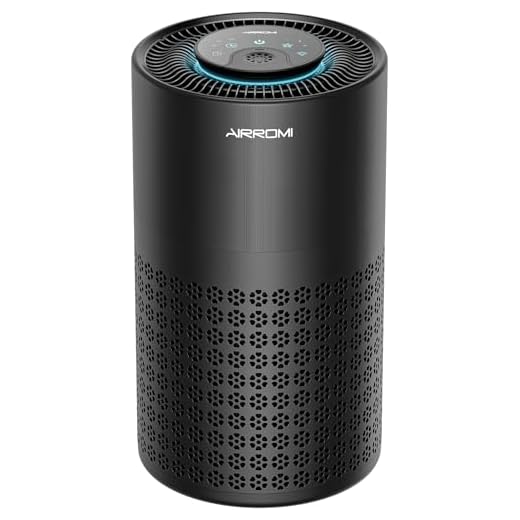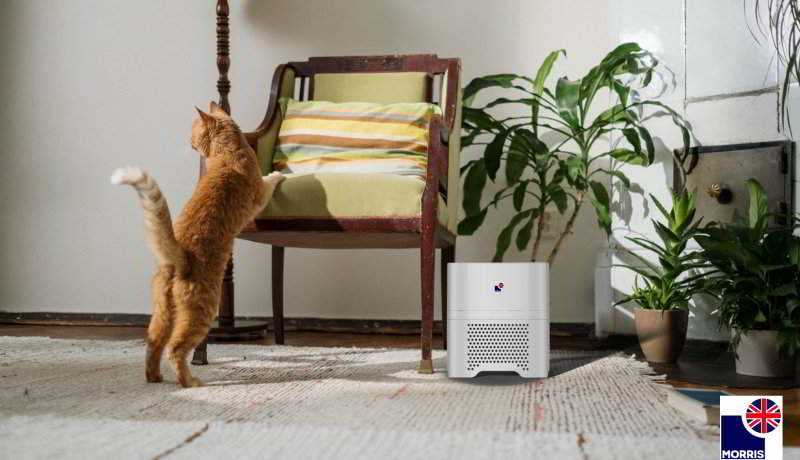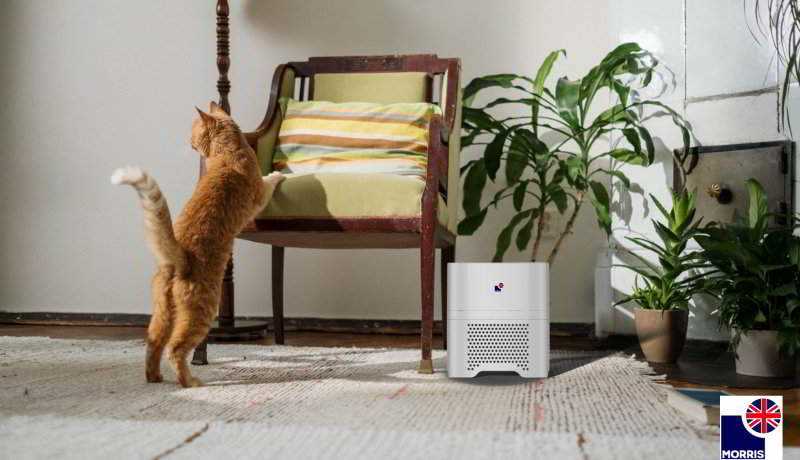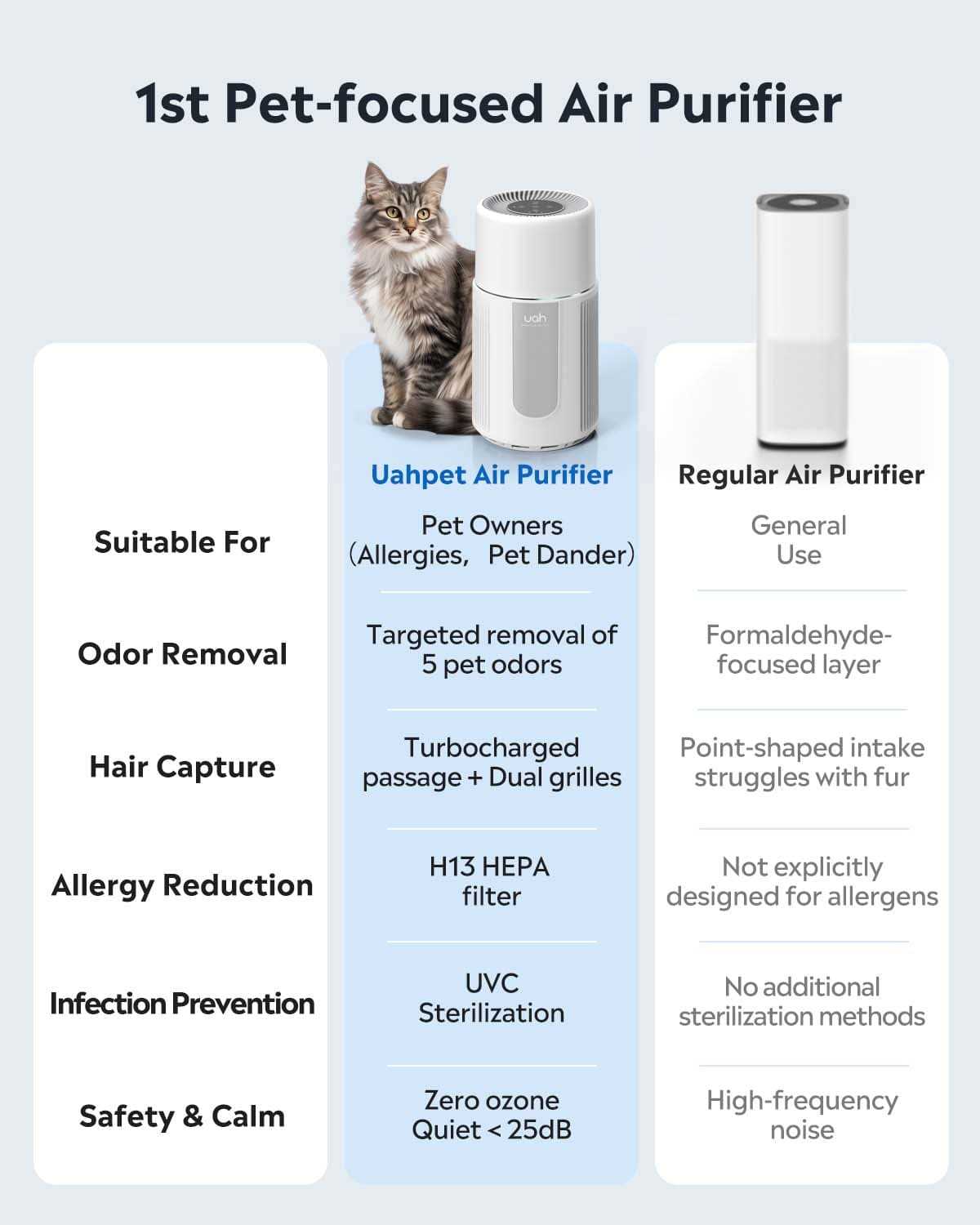



My human often asks if a device can minimize the sneezing and itchy eyes that come from my fluffy presence. The answer lies in the science of filtration. High-efficiency particulate air (HEPA) filters are designed to capture tiny particles, including dander, which is a significant trigger for sensitive individuals.
Regular maintenance is key. It’s recommended to replace filters every 6 to 12 months, depending on usage and the specific model. This ensures optimal performance and continuous removal of allergens swirling in the home.
Placement also matters. Keeping the unit in the most frequented areas, such as the living room or bedroom, can maximize its effectiveness. Some models even come with additional features like activated carbon, which can help absorb odors, making life more pleasant for everyone.
Air Cleaners and Cat Sensitivities
Choosing a quality filtration system can significantly reduce triggers associated with feline sensitivities. Look for models equipped with HEPA filters, as they capture particles as small as 0.3 microns, including pollen, dust mites, and dander.
Consider the following key points:
- Placement of the device matters. Position it in areas where your furry friend spends the most time.
- Regular maintenance is vital. Replace filters according to the manufacturer’s guidelines to ensure optimal performance.
- Check for additional features like activated carbon filters, which can assist in minimizing odors and absorbing volatile organic compounds.
For those curious about odors, it’s interesting to note how mold can mimic certain smells. For further reading, you can explore does mold smell like cat pee.
Monitoring humidity levels can also aid in reducing allergens. Keeping your home between 30-50% humidity creates an unfavorable environment for dust mites and mold growth.
Incorporating these strategies can enhance comfort for both you and your human companions, leading to a healthier living environment.
How Air Purifiers Reduce Cat Allergen Levels in Your Home
Using a filtration system can significantly lower the presence of allergens from my kind. These devices capture tiny particles, including dander, which is one of the main triggers for humans sensitive to us felines. HEPA filters are particularly proficient, trapping 99.97% of particles as small as 0.3 microns. This means that most of my fur and skin flakes become a lot less airborne.
Regular maintenance is key for optimal performance. Cleaning or replacing filters according to the manufacturer’s guidelines ensures that the system operates efficiently, maximizing its ability to filter out unwanted particles. This proactive approach can maintain a more comfortable environment for everyone in the household.
Placement matters too. Positioning the unit in areas where I spend the most time, like the living room or bedroom, can enhance its effectiveness. Additionally, keeping doors and windows closed while it’s running helps prevent outside allergens from mingling with indoor air.
Some advanced models even include UV light technology, which can eliminate bacteria and viruses, providing an extra layer of protection. It’s like having my own little fortress against irritants!
For those wondering about my diet, it’s interesting to note that some pets, like reptiles, might even be at risk from us cats. Check out this link for more on that: do cats eat bearded dragons.
Choosing the Right Air Cleaner for Allergy Relief
To effectively reduce allergens in your space, look for a device equipped with a HEPA filter. Such filters capture 99.97% of particles as small as 0.3 microns, including dander and dust. Make sure the model is certified for the size of your room; otherwise, it won’t perform optimally.
Key Features to Consider

Opt for a unit featuring multiple fan speeds. This allows for customization based on your needs, whether you require a quiet setting during the night or a stronger option during peak allergy seasons. Additionally, consider models with activated carbon filters. These filters help eliminate odors, making your environment fresher.
Maintenance and Efficiency
Regular maintenance is crucial. Check and replace filters according to the manufacturer’s guidelines to ensure continuous performance. Some devices come with filter change indicators, making this task easier. Energy efficiency is also important; look for units that have Energy Star ratings to save on electricity bills while keeping your space comfortable.
Finally, user reviews can provide insight into real-world performance. Reading about the experiences of other pet owners can guide you in choosing the right model for your needs.
Additional Measures to Complement Air Purifiers for Cat Allergies

Regular grooming sessions are essential to minimize dander. Brushing my fur helps reduce loose hair and allergens. My human should aim for at least once a week to keep things under control.
Implementing a strict cleaning schedule can make a significant difference. Vacuuming carpets, rugs, and upholstery using a vacuum equipped with a HEPA filter can effectively trap allergens. Floors should be mopped regularly to eliminate dust and other particles.
Designated Spaces

Creating allergen-free zones is beneficial. My human can establish areas where I’m not allowed, like bedrooms, to provide a refuge from allergens. This separation helps keep those spaces cleaner and safer for allergy sufferers.
Washable Items
Frequently washing bedding, curtains, and any fabric items that come into contact with me is crucial. Hot water washes can effectively eliminate allergens, keeping the surrounding environment cleaner.
Utilizing high-efficiency filters in heating and cooling systems enhances indoor air quality. Regularly changing these filters ensures they effectively trap small particles, including allergens.
Lastly, my human should consider using hypoallergenic products for cleaning and grooming. This reduces the number of irritants released into the environment, promoting a healthier living space.
My human often asks if a device can minimize the sneezing and itchy eyes that come from my fluffy presence. The answer lies in the science of filtration. High-efficiency particulate air (HEPA) filters are designed to capture tiny particles, including dander, which is a significant trigger for sensitive individuals.
Regular maintenance is key. It’s recommended to replace filters every 6 to 12 months, depending on usage and the specific model. This ensures optimal performance and continuous removal of allergens swirling in the home.
Placement also matters. Keeping the unit in the most frequented areas, such as the living room or bedroom, can maximize its effectiveness. Some models even come with additional features like activated carbon, which can help absorb odors, making life more pleasant for everyone.
Air Cleaners and Cat Sensitivities
Choosing a quality filtration system can significantly reduce triggers associated with feline sensitivities. Look for models equipped with HEPA filters, as they capture particles as small as 0.3 microns, including pollen, dust mites, and dander.
Consider the following key points:
- Placement of the device matters. Position it in areas where your furry friend spends the most time.
- Regular maintenance is vital. Replace filters according to the manufacturer’s guidelines to ensure optimal performance.
- Check for additional features like activated carbon filters, which can assist in minimizing odors and absorbing volatile organic compounds.
For those curious about odors, it’s interesting to note how mold can mimic certain smells. For further reading, you can explore does mold smell like cat pee.
Monitoring humidity levels can also aid in reducing allergens. Keeping your home between 30-50% humidity creates an unfavorable environment for dust mites and mold growth.
Incorporating these strategies can enhance comfort for both you and your human companions, leading to a healthier living environment.
How Air Purifiers Reduce Cat Allergen Levels in Your Home
Using a filtration system can significantly lower the presence of allergens from my kind. These devices capture tiny particles, including dander, which is one of the main triggers for humans sensitive to us felines. HEPA filters are particularly proficient, trapping 99.97% of particles as small as 0.3 microns. This means that most of my fur and skin flakes become a lot less airborne.
Regular maintenance is key for optimal performance. Cleaning or replacing filters according to the manufacturer’s guidelines ensures that the system operates efficiently, maximizing its ability to filter out unwanted particles. This proactive approach can maintain a more comfortable environment for everyone in the household.
Placement matters too. Positioning the unit in areas where I spend the most time, like the living room or bedroom, can enhance its effectiveness. Additionally, keeping doors and windows closed while it’s running helps prevent outside allergens from mingling with indoor air.
Some advanced models even include UV light technology, which can eliminate bacteria and viruses, providing an extra layer of protection. It’s like having my own little fortress against irritants!
For those wondering about my diet, it’s interesting to note that some pets, like reptiles, might even be at risk from us cats. Check out this link for more on that: do cats eat bearded dragons.
Choosing the Right Air Cleaner for Allergy Relief
To effectively reduce allergens in your space, look for a device equipped with a HEPA filter. Such filters capture 99.97% of particles as small as 0.3 microns, including dander and dust. Make sure the model is certified for the size of your room; otherwise, it won’t perform optimally.
Key Features to Consider

Opt for a unit featuring multiple fan speeds. This allows for customization based on your needs, whether you require a quiet setting during the night or a stronger option during peak allergy seasons. Additionally, consider models with activated carbon filters. These filters help eliminate odors, making your environment fresher.
Maintenance and Efficiency
Regular maintenance is crucial. Check and replace filters according to the manufacturer’s guidelines to ensure continuous performance. Some devices come with filter change indicators, making this task easier. Energy efficiency is also important; look for units that have Energy Star ratings to save on electricity bills while keeping your space comfortable.
Finally, user reviews can provide insight into real-world performance. Reading about the experiences of other pet owners can guide you in choosing the right model for your needs.
Additional Measures to Complement Air Purifiers for Cat Allergies

Regular grooming sessions are essential to minimize dander. Brushing my fur helps reduce loose hair and allergens. My human should aim for at least once a week to keep things under control.
Implementing a strict cleaning schedule can make a significant difference. Vacuuming carpets, rugs, and upholstery using a vacuum equipped with a HEPA filter can effectively trap allergens. Floors should be mopped regularly to eliminate dust and other particles.
Designated Spaces

Creating allergen-free zones is beneficial. My human can establish areas where I’m not allowed, like bedrooms, to provide a refuge from allergens. This separation helps keep those spaces cleaner and safer for allergy sufferers.
Washable Items
Frequently washing bedding, curtains, and any fabric items that come into contact with me is crucial. Hot water washes can effectively eliminate allergens, keeping the surrounding environment cleaner.
Utilizing high-efficiency filters in heating and cooling systems enhances indoor air quality. Regularly changing these filters ensures they effectively trap small particles, including allergens.
Lastly, my human should consider using hypoallergenic products for cleaning and grooming. This reduces the number of irritants released into the environment, promoting a healthier living space.
My human often asks if a device can minimize the sneezing and itchy eyes that come from my fluffy presence. The answer lies in the science of filtration. High-efficiency particulate air (HEPA) filters are designed to capture tiny particles, including dander, which is a significant trigger for sensitive individuals.
Regular maintenance is key. It’s recommended to replace filters every 6 to 12 months, depending on usage and the specific model. This ensures optimal performance and continuous removal of allergens swirling in the home.
Placement also matters. Keeping the unit in the most frequented areas, such as the living room or bedroom, can maximize its effectiveness. Some models even come with additional features like activated carbon, which can help absorb odors, making life more pleasant for everyone.
Air Cleaners and Cat Sensitivities
Choosing a quality filtration system can significantly reduce triggers associated with feline sensitivities. Look for models equipped with HEPA filters, as they capture particles as small as 0.3 microns, including pollen, dust mites, and dander.
Consider the following key points:
- Placement of the device matters. Position it in areas where your furry friend spends the most time.
- Regular maintenance is vital. Replace filters according to the manufacturer’s guidelines to ensure optimal performance.
- Check for additional features like activated carbon filters, which can assist in minimizing odors and absorbing volatile organic compounds.
For those curious about odors, it’s interesting to note how mold can mimic certain smells. For further reading, you can explore does mold smell like cat pee.
Monitoring humidity levels can also aid in reducing allergens. Keeping your home between 30-50% humidity creates an unfavorable environment for dust mites and mold growth.
Incorporating these strategies can enhance comfort for both you and your human companions, leading to a healthier living environment.
How Air Purifiers Reduce Cat Allergen Levels in Your Home
Using a filtration system can significantly lower the presence of allergens from my kind. These devices capture tiny particles, including dander, which is one of the main triggers for humans sensitive to us felines. HEPA filters are particularly proficient, trapping 99.97% of particles as small as 0.3 microns. This means that most of my fur and skin flakes become a lot less airborne.
Regular maintenance is key for optimal performance. Cleaning or replacing filters according to the manufacturer’s guidelines ensures that the system operates efficiently, maximizing its ability to filter out unwanted particles. This proactive approach can maintain a more comfortable environment for everyone in the household.
Placement matters too. Positioning the unit in areas where I spend the most time, like the living room or bedroom, can enhance its effectiveness. Additionally, keeping doors and windows closed while it’s running helps prevent outside allergens from mingling with indoor air.
Some advanced models even include UV light technology, which can eliminate bacteria and viruses, providing an extra layer of protection. It’s like having my own little fortress against irritants!
For those wondering about my diet, it’s interesting to note that some pets, like reptiles, might even be at risk from us cats. Check out this link for more on that: do cats eat bearded dragons.
Choosing the Right Air Cleaner for Allergy Relief
To effectively reduce allergens in your space, look for a device equipped with a HEPA filter. Such filters capture 99.97% of particles as small as 0.3 microns, including dander and dust. Make sure the model is certified for the size of your room; otherwise, it won’t perform optimally.
Key Features to Consider

Opt for a unit featuring multiple fan speeds. This allows for customization based on your needs, whether you require a quiet setting during the night or a stronger option during peak allergy seasons. Additionally, consider models with activated carbon filters. These filters help eliminate odors, making your environment fresher.
Maintenance and Efficiency
Regular maintenance is crucial. Check and replace filters according to the manufacturer’s guidelines to ensure continuous performance. Some devices come with filter change indicators, making this task easier. Energy efficiency is also important; look for units that have Energy Star ratings to save on electricity bills while keeping your space comfortable.
Finally, user reviews can provide insight into real-world performance. Reading about the experiences of other pet owners can guide you in choosing the right model for your needs.
Additional Measures to Complement Air Purifiers for Cat Allergies

Regular grooming sessions are essential to minimize dander. Brushing my fur helps reduce loose hair and allergens. My human should aim for at least once a week to keep things under control.
Implementing a strict cleaning schedule can make a significant difference. Vacuuming carpets, rugs, and upholstery using a vacuum equipped with a HEPA filter can effectively trap allergens. Floors should be mopped regularly to eliminate dust and other particles.
Designated Spaces

Creating allergen-free zones is beneficial. My human can establish areas where I’m not allowed, like bedrooms, to provide a refuge from allergens. This separation helps keep those spaces cleaner and safer for allergy sufferers.
Washable Items
Frequently washing bedding, curtains, and any fabric items that come into contact with me is crucial. Hot water washes can effectively eliminate allergens, keeping the surrounding environment cleaner.
Utilizing high-efficiency filters in heating and cooling systems enhances indoor air quality. Regularly changing these filters ensures they effectively trap small particles, including allergens.
Lastly, my human should consider using hypoallergenic products for cleaning and grooming. This reduces the number of irritants released into the environment, promoting a healthier living space.








